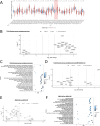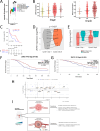This is a preprint.
ZNFX1 is a Novel Master Regulator in Epigenetically-induced Pathogen Mimicry and Inflammasome Signaling in Cancer
- PMID: 39484607
- PMCID: PMC11526927
- DOI: 10.1101/2024.10.18.618659
ZNFX1 is a Novel Master Regulator in Epigenetically-induced Pathogen Mimicry and Inflammasome Signaling in Cancer
Update in
-
ZNFX1 Functions as a Master Regulator of Epigenetically Induced Pathogen Mimicry and Inflammasome Signaling in Cancer.Cancer Res. 2025 Apr 3;85(7):1183-1198. doi: 10.1158/0008-5472.CAN-24-1286. Cancer Res. 2025. PMID: 39804147 Free PMC article.
Abstract
DNA methyltransferase and poly(ADP-ribose) polymerase inhibitors (DNMTis, PARPis) induce a stimulator of interferon (IFN) genes (STING)-dependent pathogen mimicry response (PMR) in ovarian (OC) and other cancers. We now show that combining DNMTis and PARPis upregulates expression of a little-studied nucleic-acid sensor, NFX1-type zinc finger-containing 1 protein (ZNFX1). We demonstrate that ZNFX1 is a novel master regulator for PMR induction in mitochondria, serving as a gateway for STING-dependent PMR. In patient OC databases, high ZNFX1 expression levels correlate with advanced stage disease. ZNFX1 expression alone significantly correlates with an increase in overall survival in a phase 3 trial for therapy-resistant OC patients receiving bevacizumab in combination with chemotherapy. In correlative RNA-seq data, inflammasome signaling through ZNFX1 correlates with abnormal vasculogenesis. ZNFX1 controls PMR signaling through the mitochondria and may serve as a biomarker to facilitate offering personalized therapy in OC patients, highlighting the strong translational significance of our findings.
Keywords: DNA damage; STING; ZNFX1; inflammasome; interferon; mitochondria; ovarian cancer; reactive oxygen species; tumor suppressor; viral mimicry.
Conflict of interest statement
Disclosure of Conflicts of Interest F.V.R. and S.B.B. share co-inventorship on US Provisional Patent Application Number: 61/929,680 for the concept of the combinatorial therapy. The opinions expressed in this article are the author’s own and do not reflect the view of the National Institutes of Health, the Department of Health and Human Services, or the United States government. All other authors declare no potential conflicts of interest.
Figures




References
Publication types
Grants and funding
LinkOut - more resources
Full Text Sources
Research Materials
